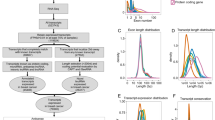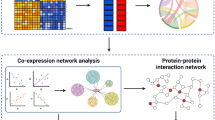Abstract
Background
Non-coding RNAs (ncRNAs) have a crucial impact on diverse cellular processes, influencing the progression of breast cancer (BC). The objective of this study was to identify novel ncRNAs in BC with potential effects on patient survival and disease progression.
Methods
We utilized the cancer genome atlas data to identify ncRNAs associated with BC pathogenesis. We explored the association between these ncRNA expressions and survival rates. A risk model was developed using candidate ncRNA expression and beta coefficients obtained from a multivariate Cox regression analysis. Co-expression networks were constructed to determine potential relationships between these ncRNAs and molecular pathways. For validation, we employed BC samples and the RT-qPCR method.
Results
Our findings revealed a noteworthy increase in the expression of AC093850.2 and CHCHD2P9 in BC, which was correlated with a poor prognosis. In contrast, ADAMTS9-AS1 and ZNF204P displayed significant downregulation and were associated with a favorable prognosis. The risk model, incorporating these four ncRNAs, robustly predicted patient survival. The co-expression network showed an effective association between levels of AC093850.2, CHCHD2P9, ADAMTS9-AS1, and ZNF204P and genes involved in pathways like metastasis, angiogenesis, metabolism, and DNA repair. The RT-qPCR results verified notable alterations in the expression of CHCHD2P9 and ZNF204P in BC samples. Pan-cancer analyses revealed alterations in the expression of these two ncRNAs across various cancer types.
Conclusion
This study presents a groundbreaking discovery, highlighting the substantial dysregulation of CHCHD2P9 and ZNF204P in BC and other cancers, with implications for patient survival.








Similar content being viewed by others
Data availability
No datasets were generated or analysed during the current study.
Abbreviations
- ncRNAs:
-
non-coding RNAs
- BC:
-
breast cancer
- lncRNAs:
-
long non-coding RNAs
- TCGA:
-
the cancer genome atlas
- K-M:
-
Kaplan-Meier
- ROC:
-
receiver operating characteristic
References
Sung H, Ferlay J, Siegel RL, Laversanne M, Soerjomataram I, Jemal A et al (2021) Global cancer statistics 2020: GLOBOCAN estimates of incidence and mortality worldwide for 36 cancers in 185 countries. Cancer J Clin 71(3):209–249
Guo L, Kong D, Liu J, Zhan L, Luo L, Zheng W et al (2023) Breast cancer heterogeneity and its implication in personalized precision therapy. Experimental Hematol Oncol 12(1):1–27
Waks AG, Winer EP (2019) Breast cancer treatment: a review. JAMA 321(3):288–300
Hombach S, Kretz M (2016) Non-coding RNAs: classification, biology and functioning. Non-coding RNAs in colorectal cancer. 3–17
Vikram R, Ramachandran R, Abdul KSM (2014) Functional significance of long non-coding RNAs in breast cancer. Breast Cancer 21:515–521
Poliseno L, Marranci A, Pandolfi PP (2015) Pseudogenes in human cancer. Front Med 2:68
Mahdevar M, Vatandoost J, Forootan FS, Kiani-Esfahani A, Esmaeili M, Peymani M, et al (2021) Steroid receptor RNA activator gene footprint in the progression and drug resistance of colorectal cancer through oxidative phosphorylation pathway. Life Sci 285:119950
Colaprico A, Silva TC, Olsen C, Garofano L, Cava C, Garolini D et al (2016) TCGAbiolinks: an R/Bioconductor package for integrative analysis of TCGA data. Nucleic Acids Res 44(8):e71–e
Law CW, Chen Y, Shi W, Smyth GK (2014) Voom: Precision weights unlock linear model analysis tools for RNA-seq read counts. Genome Biol 15(2):1–17
Yan H, Bu P (2021) Non-coding RNA in cancer. Essays Biochem 65(4):625–639
Sharma VK, Sharma RK, Singh SK (2014) Antisense oligonucleotides: modifications and clinical trials. MedChemComm 5(10):1454–1471
Li W, Cheng Y, Cheng J, Yao J, Song M, Yan M et al (2023) Long noncoding RNA LINC01614 is a diagnostic and prognostic marker for breast Cancer. Discov Med 35(174):19–27
Vishnubalaji R, Shaath H, Elkord E, Alajez NM (2019) Long non-coding RNA (lncRNA) transcriptional landscape in breast cancer identifies LINC01614 as non-favorable prognostic biomarker regulated by TGFβ and focal adhesion kinase (FAK) signaling. Cell Death Discovery 5(1):109
Dong X, ** C, Chen D, Chen Y, Ye Z-q, Zhang X et al (2021) Genomic instability-related LncRNA signature predicts the prognosis and highlights LINC01614 is a tumor microenvironment-related oncogenic lncRNA of papillary thyroid carcinoma. Front Oncol 11:737867
Jia J, Guo P, Zhang L, Kong W, Wang F (2023) LINC01614 Promotes Colorectal Cancer Cell Growth and Migration by Regulating miR-217-5p/HMGA1 Axis. Analytical Cellular Pathology. ;2023
Liu AN, Qu HJ, Yu CY, Sun P (2018) Knockdown of LINC01614 inhibits lung adenocarcinoma cell progression by up-regulating miR‐217 and down‐regulating FOXP1. J Cell Mol Med 22(9):4034–4044
Wang Z, Yan H, Cheng D, Xu L, Shen T, Chen Y et al (2021) RETRACTED ARTICLE: Novel lncRNA LINC01614 facilitates bladder Cancer Proliferation, Migration and Invasion through the miR-217/RUNX2/Wnt/β-Catenin Axis. Cancer Manage Res. 8387–8397
Lu G, Li Y, Ma Y, Lu J, Chen Y, Jiang Q et al (2018) Long noncoding RNA LINC00511 contributes to breast cancer tumourigenesis and stemness by inducing the miR-185-3p/E2F1/Nanog axis. J Experimental Clin cancer Res 37:1–11
Ghafouri-Fard S, Safarzadeh A, Hussen BM, Taheri M, Ayatollahi SA (2023) A review on the role of LINC00511 in cancer. Front Genet 14:1116445
Fang S, Zhao Y, Hu X (2020) LncRNA ADAMTS9-AS1 restrains the aggressive traits of breast carcinoma cells via sponging miR-513a-5p. Cancer Manage Res. 10693–10703
Li N, Li J, Mi Q, **e Y, Li P, Wang L et al (2020) Long non-coding RNA ADAMTS9‐AS1 suppresses colorectal cancer by inhibiting the Wnt/β‐catenin signalling pathway and is a potential diagnostic biomarker. J Cell Mol Med 24(19):11318–11329
Wang P, Zhang Y, Lv X, Zhou J, Cang S, Song Y (2023) LncRNA ADAMTS9-AS1 inhibits the stemness of lung adenocarcinoma cells by regulating miR-5009-3p/NPNT axis. Genomics 115(3):110596
**ao R, Yang M, Tan Y, Ding R, Li D (2021) Identification of five immune-related lncRNAs predicting survival and tumor microenvironment characteristics in breast cancer. Comput Math Methods Med 2021:1–12
Ma J, Lin X, Wang X, Min Q, Wang T, Tang C (2021) Reconstruction and analysis of the immune-related LINC00987/A2M axis in lung adenocarcinoma. Front Mol Biosci 8:644557
Li J, Kang J, Liu W, Liu J, Pan G, Mao A et al (2022) Docetaxel-resistant triple-negative breast cancer cell-derived exosomal lncRNA LINC00667 reduces the chemosensitivity of breast cancer cells to docetaxel via targeting miR-200b-3p/Bcl-2 axis. Eur J Histochemistry: EJH. ;66(4)
Qin Z, Liu X, Li Z, Wang G, Feng Z, Liu Y et al (2021) LncRNA LINC00667 aggravates the progression of hepatocellular carcinoma by regulating androgen receptor expression as a miRNA-130a-3p sponge. Cell Death Discovery 7(1):387
Yang H, Yang W, Dai W, Ma Y, Zhang G (2020) LINC00667 promotes the proliferation, migration, and pathological angiogenesis in non–small cell lung cancer through stabilizing VEGFA by EIF4A3. Cell Biol Int 44(8):1671–1680
Yu J, Wang F, Zhang J, Li J, Chen X, Han G (2020) LINC00667/miR-449b-5p/YY1 axis promotes cell proliferation and migration in colorectal cancer. Cancer Cell Int 20:1–13
Monaco ME (2017) Fatty acid metabolism in breast cancer subtypes. Oncotarget 8(17):29487
Wu R, Yu I, Tokumaru Y, Asaoka M, Oshi M, Yan L et al (2022) Elevated bile acid metabolism and microbiome are associated with suppressed cell proliferation and better survival in breast cancer. Am J Cancer Res 12(11):5271
Modi A, Roy D, Sharma S, Vishnoi JR, Pareek P, Elhence P et al (2022) ABC transporters in breast cancer: their roles in multidrug resistance and beyond. J Drug Target 30(9):927–947
Acknowledgements
Thanks to Genius Gene center for assisting in laboratory work and data analysis.
Funding
Not available.
Author information
Authors and Affiliations
Contributions
The study design was performed by H.S. and A.D. Data analysis and experiments were done by M.R. Interpretations of data were performed by M.R. and A.D. Bioinformatics analysis was performed by M.R. Manuscript writing was performed by M.R. The manuscript was finally approved by M.R., H.S. and A.D.
Corresponding author
Ethics declarations
Ethical approval and consent to participate
Ethics approval was obtained from the Research Ethics Committees of Islamic Azad University with Ethical approval number; IR.IAU.SHK.REC.1401.091. All experiments were performed in accordance with relevant guidelines and regulations. Informed consent was obtained from all the donors prior to the collection of samples.
Consent for publication
All authors support the submission of the present manuscript to this journal.
Competing interests
The authors declare no competing interests.
Additional information
Publisher’s Note
Springer Nature remains neutral with regard to jurisdictional claims in published maps and institutional affiliations.
Electronic supplementary material
Below is the link to the electronic supplementary material.
Rights and permissions
Springer Nature or its licensor (e.g. a society or other partner) holds exclusive rights to this article under a publishing agreement with the author(s) or other rightsholder(s); author self-archiving of the accepted manuscript version of this article is solely governed by the terms of such publishing agreement and applicable law.
About this article
Cite this article
Rastegari, M., Sazegar, H. & Doosti, A. Prognostic significance of CHCHD2P9 and ZNF204P in breast cancer: exploring their expression patterns and associations with malignancy-related genes. Mol Biol Rep 51, 707 (2024). https://doi.org/10.1007/s11033-024-09643-x
Received:
Accepted:
Published:
DOI: https://doi.org/10.1007/s11033-024-09643-x




